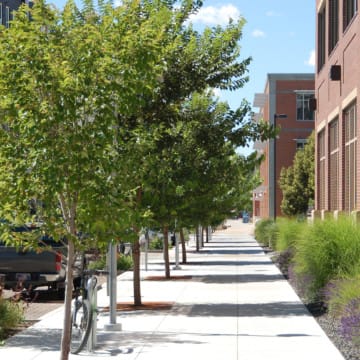Urban Canopy Policy
Cincinnati created a dedicated funding stream for its urban forestry program in 1981 that has enabled the city to maintain a high percentage of its tree canopy. Heat mitigation is a key reason tree canopy is a priority. Although Cincinnati has a temperate climate and harsh, cold winters, the urban heat island effect can make the city up to 17°F hotter than nearby rural areas during the summer.
According to Larry Falkin, the director of Cincinnati’s Office of Environment and Sustainability, tree canopy is “the most straightforward strategy” for reducing the urban heat island effect.” Cincinnati’s 2018 Green Cincinnati Plan states that urban canopy cover “will help minimize the effects of urban heat islands,” “reduce the cost of cooling for residents,” and “reduce the concentrations of air pollutants,” as well as help mitigate flood, stormwater, and landslide risks.
In addition to mitigating climate and environmental hazards, Cincinnati prioritizes maintaining a healthy urban tree canopy as a public safety and social equity strategy. “It’s very important to make sure that the stormwater, heat island effect mitigation, simple habitat and air quality benefits of trees are shared equally among the population,” says Crystal Courtney, Cincinnati’s urban forestry supervisor in the Parks Department.
Extreme Heat Resilience Strategies
Cincinnati uses an assessment that allows it to collect an annual levy for the control, planting, care, and maintenance of shade trees. This regulation is unique to Ohio and is guided at the state level by Revised Code 727. The Urban Forestry Assessment began with the inception of the Urban Forestry Division in 1981, requiring property owners to pay $0.05 per linear foot of frontage along a public right-of-way. The assessment follows the same process today and applies equally to every sector, including private, public, nonprofit, and government-owned land.
In 2018, the City Council voted to increase the requirement to $0.21 per foot. In total, the assessment amount has gradually increased 32 percent over almost 40 years. The increase covers the inflation costs of maintenance, additional tree plantings to address canopy loss caused by the tree-killing Emerald Ash Borer beetle, and achieving Cincinnati’s increased urban canopy cover goals. In its 2018 sustainability plan, Cincinnati established a goal to increase the citywide tree canopy coverage to at least 40 percent and to ensure that canopy cover is at least 30 percent in all residential neighborhoods.
The assessment process is governed by three city ordinances, which are renewed annually. The Board of Park Commissioners and the City Council approve the annual assessment level.
Cincinnati has a big advantage because in our Parks Department, we have an Urban Forestry Division and we have a dedicated funding stream for our urban forest. –Larry Falkin, Director, Cincinnati’s Office of Environment and Sustainability
Owners see the charge as an individual item on their property assessment. “The typical situation is a 50-foot property frontage times 21 cents plus a county admin fee,” says Urban Forestry Specialist Robin Hunt. “There are some cases where property owners have up to three sides with the right-of-way; however, the average homeowner pays $15 each year.” Property owners are notified if they owe $250 or more, but there is no maximum payment amount.
Outcome
The outcome of the well-funded program is a higher than national average urban canopy cover; with 38 percent tree cover as of 2010, Cincinnati is close to meeting its goal of 40 percent citywide tree cover.
The assessment levy funds the Urban Forestry section of Cincinnati’s Parks Department (including all staff) and makes possible regular tree maintenance and analysis of progress. The funds give “the opportunity to focus on what we want our urban forests to look like,” elaborates Courtney. “It allows us to work as experts in urban forestry and manage contracts as they relate to tree maintenance and the continuation of the next generation of forest.”
The Urban Forestry Division inspects and maintains about 12,000 trees each year. Even with preventive maintenance, Urban Forestry uses funds from the property assessment to respond to about 800 emergency calls each year following extreme rainfall or other storm events to, for example, clear tree-blocked roadways. “Preparedness for emergency tree maintenance is something that needs to be continually done for public safety,” says Hunt.
The assessment also enables the completion of an Urban Tree Canopy Assessment every 10 years that combines GIS canopy distribution data with census data. Cincinnati uses the results to guide management decisions and to allocate new trees in the neighborhoods with lower canopy cover. Beginning in 2020, the Urban Forestry Program will partner with the Ohio Division of Natural Resources to include fine particulate matter (a known cause of increased asthma rates) and urban heat island measurements in its mapping and decision-making.
